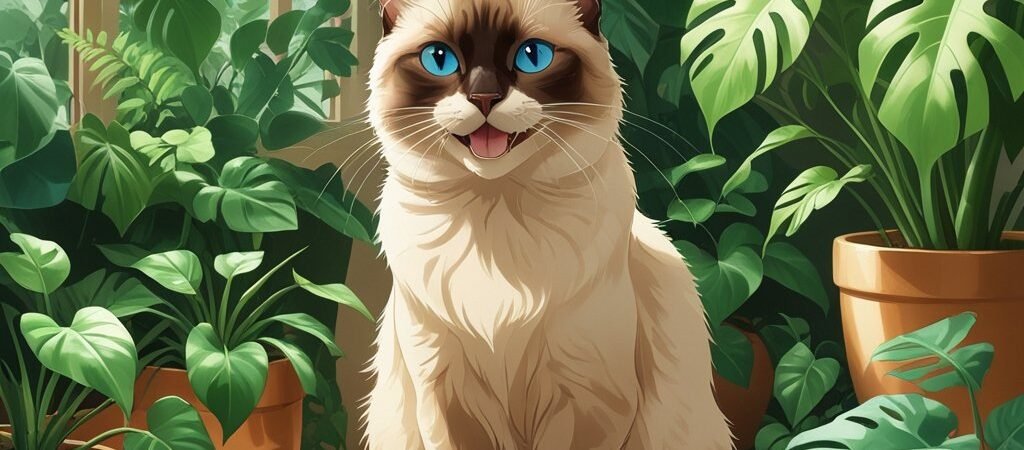Meta Description: Discover safe indoor plants for cat owners! Learn which plants are cat-friendly, which are toxic to avoid, and how to create a beautiful, safe home environment for you and your feline friend.
Creating a lush, green indoor environment while sharing your home with cats requires careful plant selection and strategic placement. Many popular houseplants are toxic to cats, causing symptoms ranging from mild digestive upset to severe organ damage or even death. However, this doesn’t mean cat owners must abandon their dreams of indoor gardening – numerous beautiful, safe plants can coexist peacefully with curious felines.
The challenge lies in identifying which plants pose dangers to your cat and which ones can safely enhance your home’s atmosphere. Cats are naturally curious creatures who love to explore, nibble, and sometimes dig in planters, making plant toxicity a serious safety concern for responsible pet parents. Understanding both the risks and the safe alternatives empowers you to create a beautiful indoor garden that enhances your living space without compromising your cat’s health.
From stunning flowering plants and dramatic foliage specimens to practical herbs and air-purifying varieties, many cat-safe options exist for every style preference and gardening skill level. By combining knowledge of safe plant choices with smart placement strategies and cat behavior understanding, you can enjoy the benefits of indoor plants while keeping your feline friend safe and healthy.
This comprehensive guide will help you navigate the world of cat-friendly indoor gardening, providing detailed information about safe plant choices, dangerous plants to avoid, and practical strategies for creating a thriving indoor garden that both you and your cat can enjoy safely.
Understanding Plant Toxicity in Cats
Before exploring specific plant recommendations, it’s crucial to understand how and why certain plants affect cats differently than humans or other pets.
How Cats Interact with Plants
Natural Exploration Behaviors: Cats use their mouths to explore interesting textures, tastes, and scents. This natural investigation behavior puts them at risk when toxic plants are within reach.
Dietary Supplementation Instincts: Many cats instinctively seek out plant matter to aid digestion, obtain nutrients, or induce vomiting when feeling unwell. This behavior makes them more likely to sample household plants.
Play and Hunting Behaviors: Dangling leaves, swaying stems, and rustling foliage trigger cats’ hunting instincts, encouraging interaction with plants through batting, pouncing, and chewing.
Grooming and Cleaning: Cats may get plant materials on their fur or paws during exploration, then ingest toxins during normal grooming behaviors.
Levels of Plant Toxicity
Mildly Toxic: Plants that cause digestive upset, mild skin irritation, or temporary discomfort but typically don’t result in serious long-term health consequences.
Moderately Toxic: Plants that can cause significant symptoms requiring veterinary attention, including persistent vomiting, diarrhea, difficulty breathing, or neurological symptoms.
Severely Toxic: Plants that can cause organ failure, severe poisoning, or death even with small amounts ingested. These require immediate emergency veterinary care.
Skin and Eye Irritants: Some plants may not be toxic when ingested but can cause irritation, burns, or allergic reactions when cats come into contact with leaves or sap.
Common Symptoms of Plant Poisoning
Digestive Symptoms: Vomiting, diarrhea, loss of appetite, excessive drooling, and difficulty swallowing are common initial signs of plant toxicity.
Neurological Signs: Confusion, difficulty walking, tremors, seizures, or changes in behavior may indicate serious poisoning requiring immediate veterinary attention.
Respiratory Issues: Difficulty breathing, coughing, or open-mouth breathing can occur with certain plant toxicities and constitute medical emergencies.
Systemic Effects: Changes in urination, heart rate abnormalities, weakness, or collapse may indicate organ involvement requiring immediate professional treatment.
Cat-Safe Indoor Plants: Beautiful and Secure Options
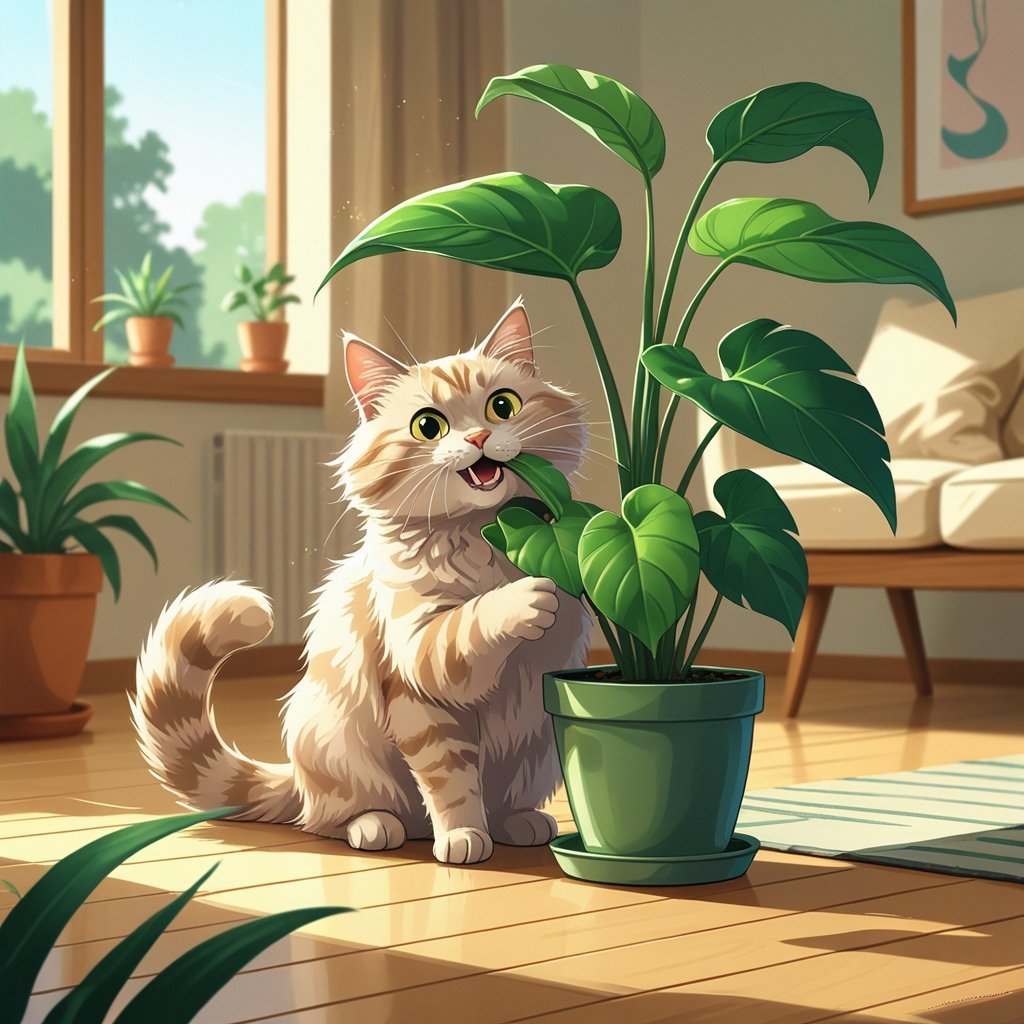
Fortunately, many stunning plants are completely safe for cats, allowing you to create diverse, attractive indoor gardens without safety concerns.
Safe Flowering Plants
African Violets (Saintpaulia): These compact, colorful flowering plants thrive in bright, indirect light and produce beautiful purple, pink, or white blooms. They’re completely safe for cats and add vibrant color to any space.
Orchids (Orchidaceae family): Most orchid varieties are safe for cats and offer exotic beauty with long-lasting blooms. Phalaenopsis orchids are particularly beginner-friendly and cat-safe.
Roses (Rosa species): While outdoor roses have thorns that might injure curious cats, thornless miniature roses grown indoors are safe and provide classic beauty and fragrance.
Snapdragons (Antirrhinum majus): These cheerful flowering plants come in numerous colors and are safe for cats. They prefer cooler conditions, making them ideal for many indoor environments.
Zinnias (Zinnia elegans): Bright, cheerful zinnias are safe for cats and can bloom indoors with adequate light. They come in many colors and sizes to suit various spaces.
Safe Foliage Plants
Spider Plants (Chlorophytum comosum): These popular houseplants are not only safe for cats but are actually mildly beneficial if nibbled. Their cascading babies make them attractive hanging plants that cats often enjoy.
Boston Ferns (Nephrolepis exaltata): Lush, green Boston ferns are safe for cats and provide excellent air purification. They prefer humid conditions and indirect light.
Ponytail Palms (Beaucarnea recurvata): Despite their name, these aren’t true palms but are completely safe for cats. Their unique bulbous base and long, thin leaves create striking architectural interest.
Parlor Palms (Chamaedorea elegans): True palms that are safe for cats, parlor palms tolerate low light conditions and add tropical flair to indoor spaces.
Prayer Plants (Maranta leuconeura): These beautiful plants with patterned leaves that fold at night are safe for cats and thrive in low to medium light conditions.
Safe Herbs for Indoor Growing
Cat Grass (Various grasses): Specifically grown for cats, cat grass provides safe nibbling opportunities and may aid in hairball elimination. Wheat grass, oat grass, and barley grass are popular varieties.
Basil (Ocimum basilicum): This culinary herb is safe for cats in small amounts and provides fresh herbs for cooking while adding aromatic appeal to your home.
Cilantro/Coriander (Coriandrum sativum): Safe for cats and useful in cooking, cilantro grows well indoors with adequate light and regular harvesting.
Dill (Anethum graveolens): This feathery herb is safe for cats and adds delicate texture to indoor herb gardens while providing culinary benefits.
Parsley (Petroselinum crispum): In small amounts, parsley is safe for cats and provides fresh herbs for cooking. However, large quantities should be avoided.
Air-Purifying Safe Plants
Bamboo Palm (Chamaedorea seifrizii): This air-purifying palm is safe for cats and helps remove indoor air pollutants while providing lush, tropical appearance.
Areca Palm (Dypsis lutescens): Another air-purifying palm that’s safe for cats, areca palms add height and drama to indoor spaces while improving air quality.
Money Tree (Pachira aquatica): Despite some conflicting information online, money trees are generally considered safe for cats and provide interesting braided trunk appeal.
Dangerous Plants to Avoid Completely
Understanding which common houseplants pose serious threats to your cat’s health is crucial for creating a safe indoor environment.
Extremely Toxic Plants – Immediate Danger
Lilies (Lilium and Hemerocallis species): All parts of true lilies and day lilies are extremely toxic to cats, causing kidney failure that can be fatal even with small ingestions. This includes Easter lilies, tiger lilies, and day lilies.
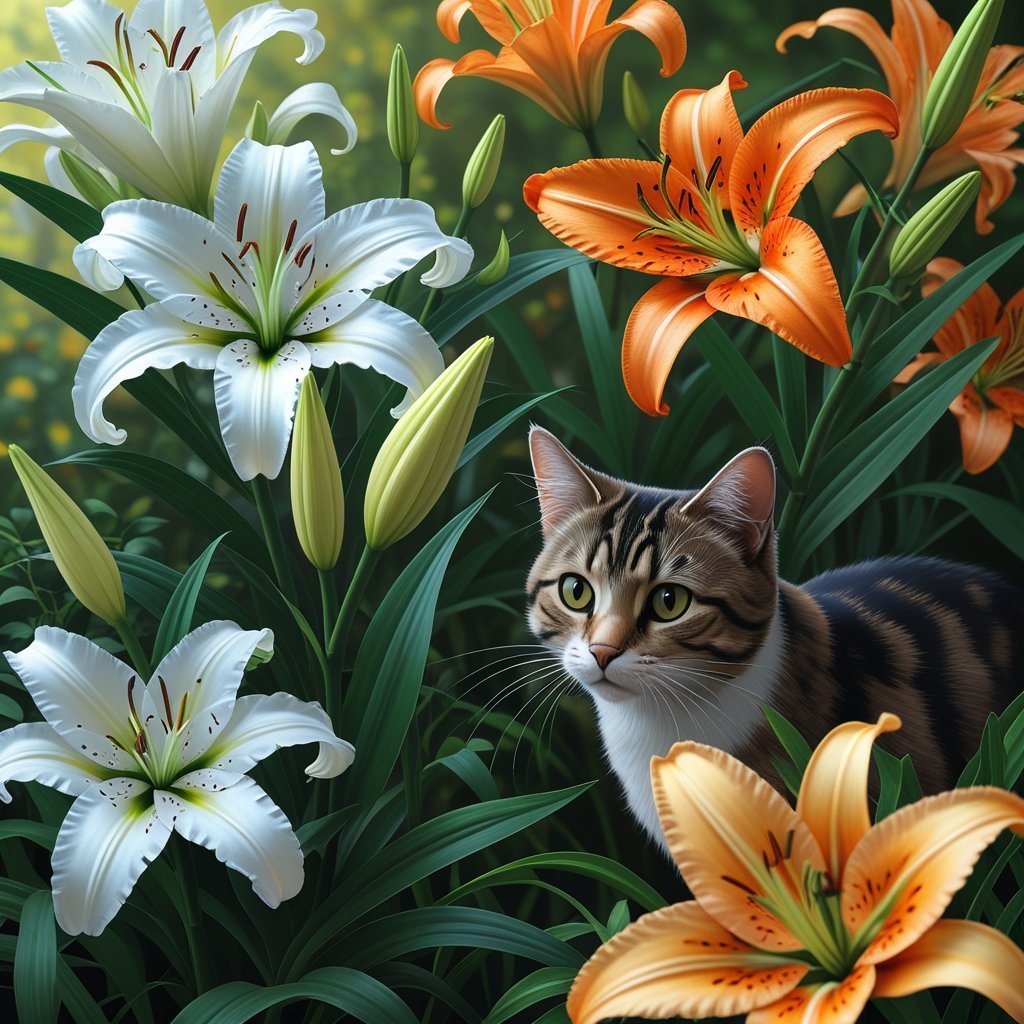
Sago Palms (Cycas revoluta): All parts of sago palms are extremely poisonous to cats, with seeds being most toxic. Ingestion can cause liver failure and death even with prompt treatment.
Oleander (Nerium oleander): This beautiful flowering plant contains cardiac glycosides that can cause heart arrhythmias and death in cats. All parts of the plant are toxic.
Azaleas and Rhododendrons (Rhododendron species): These popular flowering shrubs contain grayanotoxins that can cause heart problems, difficulty breathing, and death in cats.
Tulips and Daffodils (Tulipa and Narcissus species): The bulbs are most toxic, but all parts can cause digestive upset, heart problems, and respiratory issues in cats.
Commonly Available Toxic Plants
Pothos (Epipremnum aureum): This popular trailing houseplant contains calcium oxalates that cause mouth irritation, difficulty swallowing, and digestive upset in cats.
Peace Lily (Spathiphyllum): Despite being called a lily, peace lilies are in a different family but still contain calcium oxalates that cause mouth and throat irritation in cats.
Philodendrons (Philodendron species): These common houseplants contain calcium oxalates similar to pothos, causing mouth irritation and digestive problems in cats.
Dieffenbachia (Dieffenbachia seguine): Also known as dumb cane, this plant causes severe mouth and throat irritation that can interfere with breathing and swallowing.
Snake Plants (Sansevieria trifasciata): While mildly toxic, snake plants can cause digestive upset and may be particularly appealing to cats due to their upright, grass-like appearance.
Seasonal and Holiday Plants
Poinsettias (Euphorbia pulcherrima): While often overstated, poinsettias are mildly toxic to cats, causing digestive upset and skin irritation from the milky sap.
Christmas Trees: While not houseplants, Christmas tree needles and water can be problematic for cats. Pine needles can cause digestive irritation, and tree water may contain preservatives or bacteria.
Mistletoe (Viscum album): All parts of mistletoe are toxic to cats, potentially causing cardiovascular problems and digestive upset.
Holly (Ilex species): Holly berries and leaves can cause digestive upset and may be particularly attractive to curious cats due to their bright red berries.
Smart Placement Strategies for Plant Safety
Even with cat-safe plants, strategic placement can prevent damage to both plants and reduce any potential risks from overzealous feline attention.
Vertical Gardening Solutions
Hanging Planters: Suspended plants keep foliage out of reach while creating visual interest at various heights. Ensure hangers are secure and won’t fall if cats jump or climb nearby.
Wall-Mounted Shelves: Dedicated plant shelves can display collections safely while creating green walls that add natural beauty without floor space competition.
Tall Plant Stands: Elevate plants on sturdy stands that cats can’t easily knock over or climb. Choose stands with wide, stable bases for safety.
Ceiling-Mounted Options: Ceiling hooks and pulleys allow plants to be raised and lowered for care while keeping them safely out of reach during daily life.
Protective Barriers and Deterrents
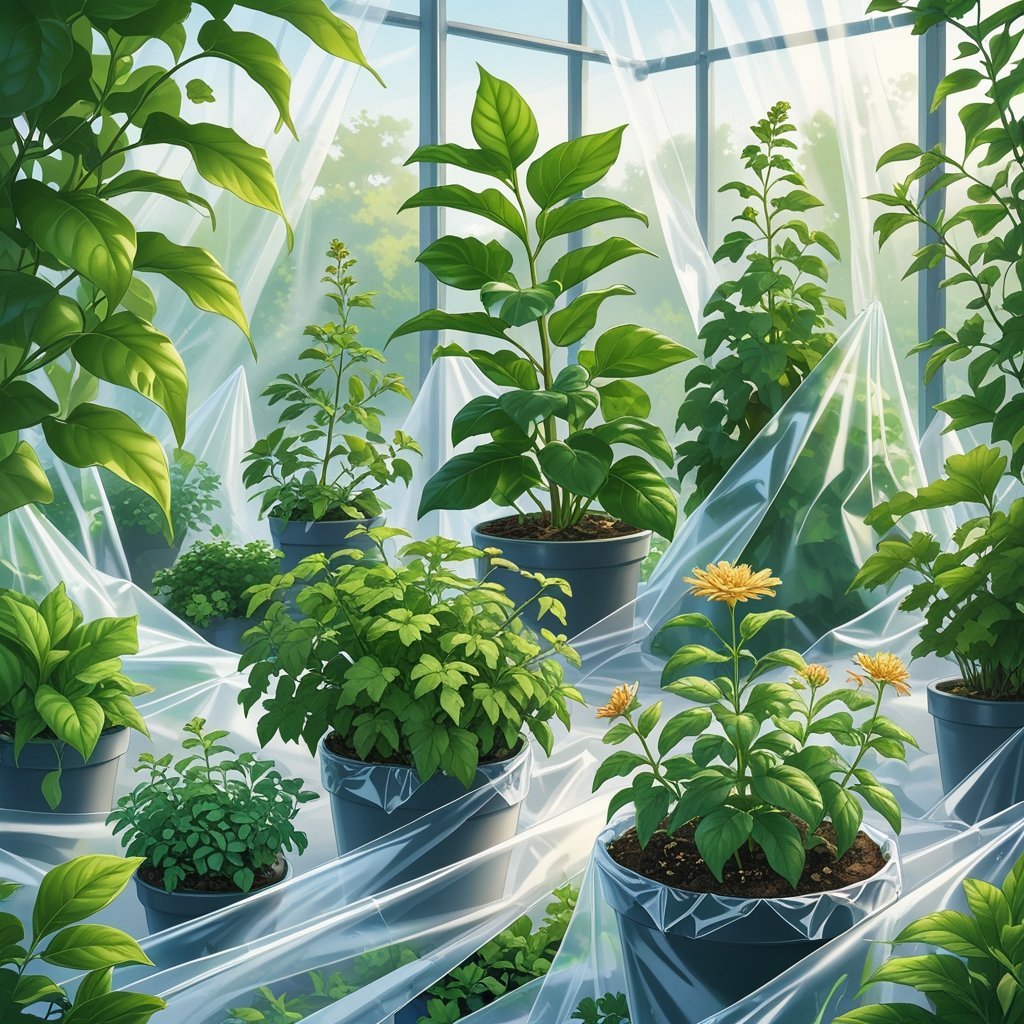
Decorative Cloches: Glass or plastic plant covers protect small plants while creating elegant Victorian-style displays that cats can see but not access.
Terrarium Gardens: Closed or semi-closed terrariums protect plants while creating fascinating miniature ecosystems that cats can observe safely.
Plant Cages: Decorative wire or wooden cages around floor plants allow light and air circulation while preventing direct plant access.
Natural Deterrents: Citrus peels, coffee grounds, or commercial pet-safe deterrent sprays around plants can discourage feline investigation without harm.
Creating Designated Cat Plant Areas
Cat Garden Spaces: Dedicate specific areas to cat-safe plants that cats are encouraged to explore, providing safe outlets for their natural plant-seeking behaviors.
Cat Grass Stations: Multiple cat grass growing stations throughout the house provide safe nibbling opportunities that may reduce interest in other plants.
Interactive Plant Features: Consider plants that move or rustle safely, like air plants in hanging terrariums, to provide visual stimulation without danger.
Caring for Plants in Cat Households
Maintaining healthy plants while living with cats requires some modifications to traditional plant care routines.
Watering and Maintenance Considerations
Drainage Management: Use saucers under pots to prevent water spillage that might create muddy play areas attractive to cats or cause slip hazards.
Soil Security: Cover soil surfaces with decorative rocks or moss to prevent digging while maintaining plant health and preventing litter-box confusion.
Pruning and Deadheading: Remove dead or dying plant material promptly to prevent cats from being attracted to changing textures or scents.
Fertilizer Safety: Use organic, pet-safe fertilizers and avoid leaving granular fertilizers accessible to curious cats who might mistake them for treats.
Pest Management in Cat Households
Pet-Safe Pest Control: Choose integrated pest management approaches that don’t rely on toxic chemicals that could harm cats who investigate or groom near treated plants.
Natural Pest Deterrents: Neem oil, insecticidal soaps, and beneficial insects provide pest control without chemical risks to cats.
Quarantine Procedures: Isolate new plants for several weeks to prevent introducing pests to established collections and to ensure they don’t harbor toxins or treatments harmful to cats.
Creating Cat Entertainment with Safe Plants
Plants can provide enrichment and entertainment for cats when chosen and arranged thoughtfully.
Sensory Enrichment Plants
Aromatic Safe Herbs: Cat-safe herbs like basil, cilantro, and cat grass provide interesting scents and textures for sensory exploration.
Textural Variety: Combine smooth-leafed plants with fuzzy or textured varieties (all cat-safe) to provide diverse tactile experiences.
Movement and Sound: Plants with leaves that rustle or move in air currents provide visual and auditory stimulation for cats.
Interactive Plant Features
Cat Grass Gardens: Create dedicated growing areas where cats are encouraged to nibble, providing healthy outlet for plant-seeking behaviors.
Climbing Integration: Arrange cat-safe plants around cat trees or climbing structures to create integrated environments that satisfy both aesthetic and feline needs.
Window Garden Displays: Combine cat-safe plants in sunny windows where cats enjoy spending time, creating appealing environments for both plants and cats.
Emergency Preparedness and Response
Despite careful plant selection and placement, accidents can happen. Being prepared for potential plant-related emergencies is crucial for cat owners.
Immediate Response Protocols
Plant Identification: Keep a list or photos of all plants in your home, including scientific names, to provide accurate information to veterinarians if needed.
Emergency Contacts: Have your veterinarian’s contact information, nearest emergency clinic, and pet poison control hotline numbers readily accessible.
First Aid Basics: Know basic first aid for plant poisoning, including when to induce vomiting (only when specifically instructed by professionals) and when to avoid it.
Documentation: If you suspect plant ingestion, collect samples of the plant and note the time, amount, and any symptoms observed.
Professional Resources
ASPCA Poison Control: The ASPCA Animal Poison Control Center (888-426-4435) provides 24/7 consultation for plant poisoning emergencies.
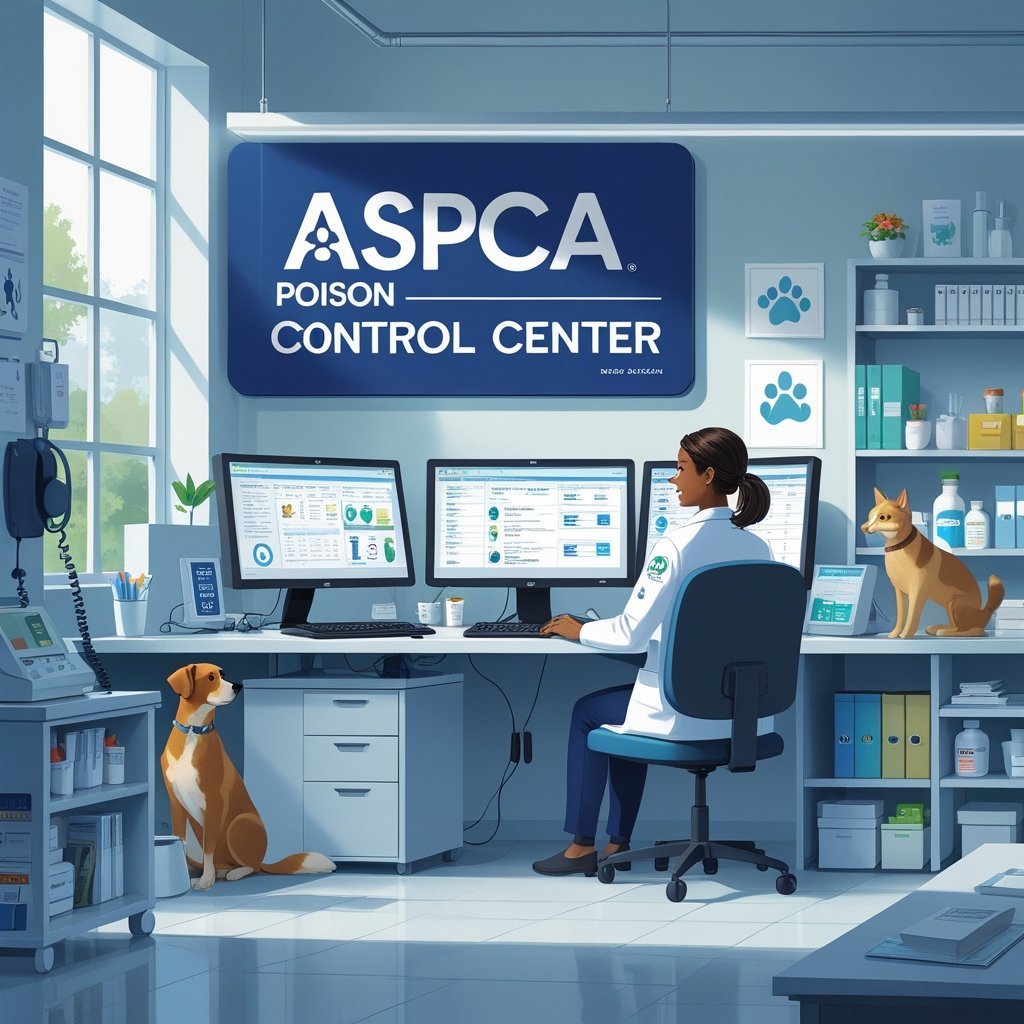
Veterinary Guidance: Establish relationships with veterinarians experienced in treating plant toxicities and emergency clinics for after-hours care.
Plant Identification Services: Use plant identification apps or contact local master gardener programs for help identifying unknown plants in your environment.
Seasonal Plant Safety Considerations
Different seasons bring unique plant safety challenges for cat owners, from holiday decorations to seasonal plant care changes.
Holiday Plant Safety
Gift Plant Screening: Screen holiday gift plants for toxicity before bringing them into cat households, and educate gift-givers about plant safety concerns.
Seasonal Decoration Safety: Choose artificial alternatives to toxic seasonal plants, or use real safe alternatives like cat grass arrangements.
Visitor Education: Inform visitors about household plant safety rules and ask them to avoid bringing potentially toxic plants as gifts or decorations.
Seasonal Care Modifications
Winter Plant Care: Reduced light and humidity in winter may stress plants, potentially making them more appealing to cats seeking fresh plant matter.
Spring Growth Management: Rapid spring growth may require more frequent pruning and maintenance to keep safe plants attractive and healthy.
Summer Protection: Increased air conditioning and temperature fluctuations may affect both plant health and cat behavior around plants.
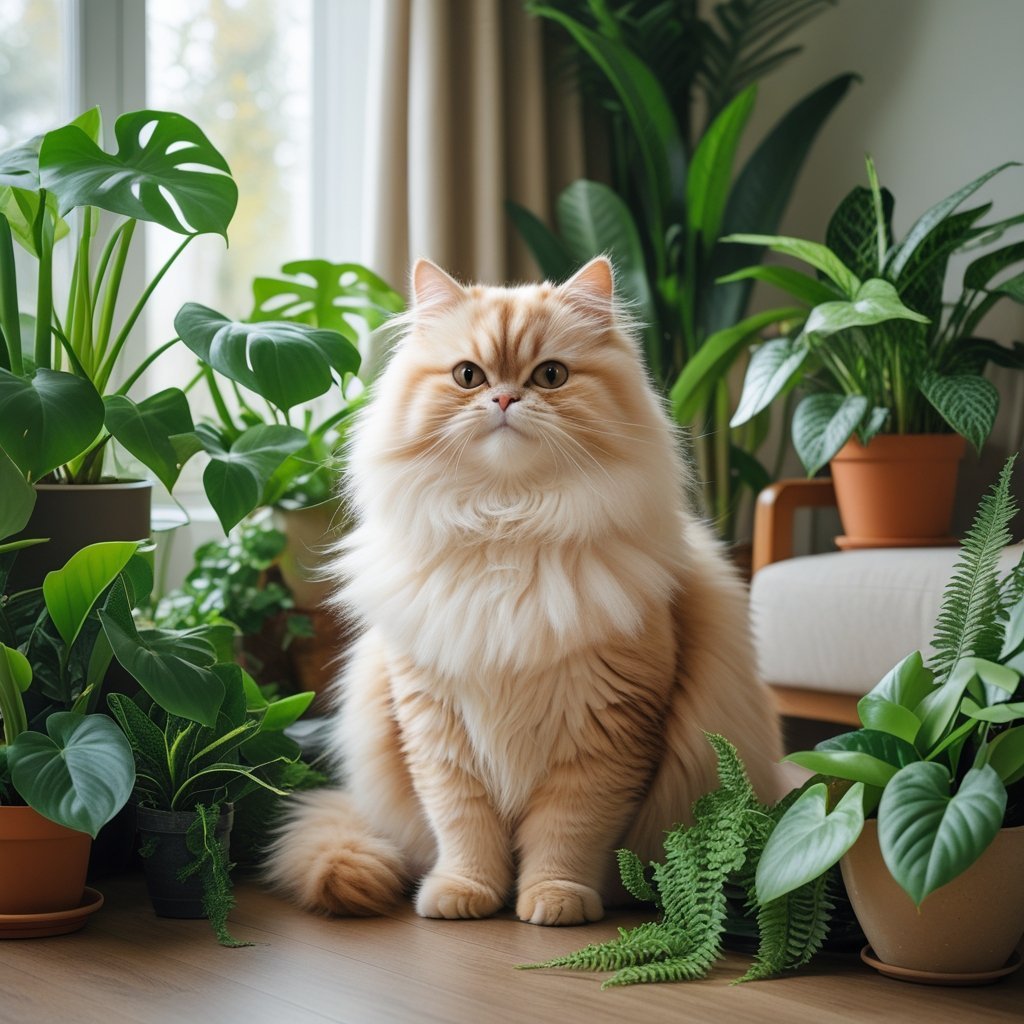
Frequently Asked Questions About Cat-Safe Indoor Plants
Q: Are all plants in the lily family toxic to cats?
A: True lilies (Lilium) and day lilies (Hemerocallis) are extremely toxic to cats, but plants called “lilies” from other families (like peace lilies or lily of the valley) have different toxicity levels. Always research the specific scientific name to determine safety.
Q: Can I make toxic plants safe by placing them out of reach?
A: While elevation reduces risk, it doesn’t eliminate it completely. Cats are excellent climbers and jumpers, leaves can fall, and pollen can spread. It’s safer to choose cat-friendly alternatives for homes with felines.
Q: How much of a toxic plant is dangerous for cats?
A: Toxicity varies greatly by plant and cat size. Some plants like lilies can cause serious problems with minimal ingestion, while others require larger amounts. Never assume any amount of a toxic plant is safe.
Q: Are artificial plants a good alternative for cat households?
A: High-quality artificial plants can provide greenery without toxicity risks, but ensure they don’t have small parts that could be ingested and that they’re made from pet-safe materials.
Q: What should I do if I’m not sure whether a plant is safe?
A: When in doubt, research the plant’s scientific name through reliable sources like the ASPCA’s toxic plant database, or choose a plant you know is definitely safe. It’s better to err on the side of caution.
Conclusion: Creating Beautiful, Safe Indoor Gardens
Living with cats doesn’t mean sacrificing your love of indoor plants. With careful selection, strategic placement, and proper safety precautions, you can create stunning indoor gardens that enhance your living space while keeping your feline companions safe and healthy.
The key to successful cat-friendly indoor gardening lies in education, preparation, and ongoing vigilance. By choosing from the wide variety of beautiful, safe plants available and avoiding known toxic varieties, you can satisfy both your gardening desires and your responsibilities as a caring cat parent.
Remember that plant safety is an ongoing consideration rather than a one-time decision. As you add new plants, rearrange your space, or welcome new cats into your home, regularly reassess your indoor garden for potential safety concerns and make adjustments as needed.
The investment in learning about plant safety pays dividends in peace of mind and allows you to fully enjoy both your beautiful plants and your beloved feline companions. Create spaces that celebrate the natural world while honoring your commitment to your cat’s health and safety.
With proper planning and plant selection, your indoor garden can become a source of joy, beauty, and enrichment for both you and your cats, proving that responsible pet ownership and passionate gardening can coexist harmoniously in the same loving home.
What cat-safe plants have you successfully grown in your home? Share your indoor gardening successes and challenges in the comments below!
Ready to create a beautiful, cat-safe indoor garden? Check out our recommendations for cat-friendly plants, secure plant stands, and pet-safe gardening supplies that let you garden with confidence in your feline-friendly home.
Related Articles You Might Enjoy:
- “Traveling with Cats: Tips for Stress-Free Trips”
- “15 Funniest Cat Behaviors Explained”
- “The Maine Coon: Giant Gentle Cats Everyone Loves”
- “How to Tell if Your Cat is Overweight (and What to Do)”
Keywords: cat-friendly plants, safe plants for cats, toxic plants cats, indoor plants cats, cat-safe houseplants, plants toxic to cats, pet-safe indoor plants, cat plant safety, feline plant toxicity

